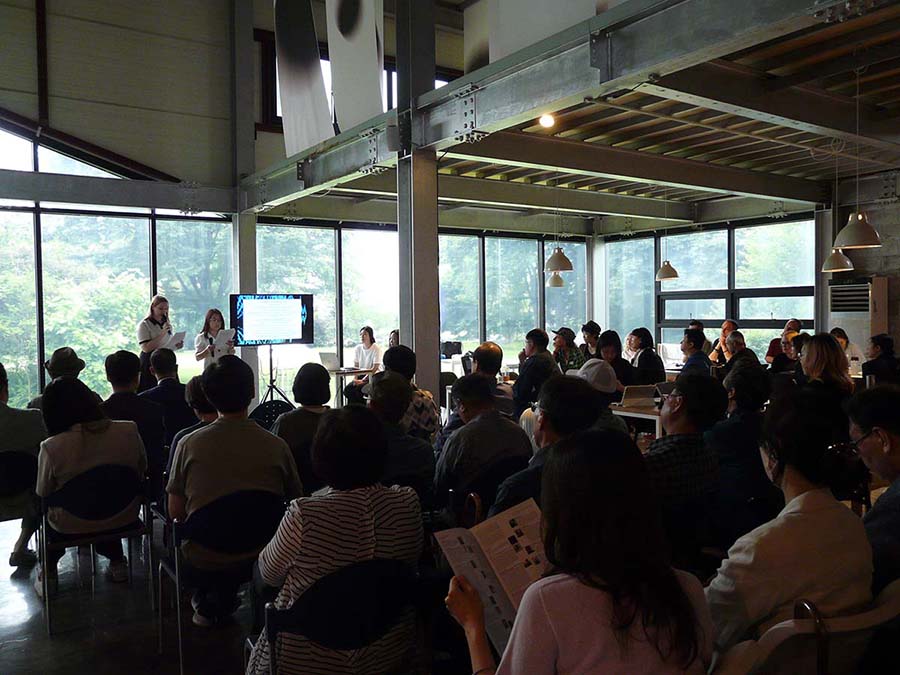
CICA NMAC 2023 Opening Party, photographed by Yi Qian
CICA NMAC 2023 Review
Chan Yi Qian
This year’s edition of CICA New Media Art Conference (CICA NMAC) from 10 to 12 June 2023 at CICA Museum featured artists and researchers from around the world gathering together in a shared open space that is both virtual and physical, exchanging expansive ideas of art-making in the age of rapid technological growth.
New media is increasingly used as a medium for art-making, akin to a collaborative force as it works alongside artists in the creation of new works. An immersive installation with new media elements was set up by Victor Drouin-Trempe and Jean-Philippe Cote. Their work is deeply informed by sound-space relations, as participants moving around the installation got to explore the presence of sound in space, with motion sensors detecting their body movements and visually reflecting them onto the screen in real-time. As Shengwei Chen pointed out in his research on immersive museum installations and their experiential effects, the elements that allow for physical interactions with the installation made for an expanded learning experience, as participants were able to visualize in real time the digital accumulation of sound data.
Among the various mediums available for experimentation, Artificial Intelligence (AI) has recently gained prominence as a tool to play with among artists such as Song Lu, who works with AI to create artworks. The AI-generated output reveals not only personal biases with keywords chosen by the artist, but also the AI’s biases, as AI uses datasets that connect to society’s preconceived notions of the keywords being input into the system. This sparked deep conversations among participants about representation and consensus in AI, and what this might mean for future AI usage. AI is also utilized as a medium by Hodoo, who creates works that center on the potential for artistic expression through AI, and the extent to which AI can interpret human sensitivities like brain waves into an artistic form as programmed by the artist. Despite the significant role AI has in such artworks, these AI-generated works do still emphasize the immense value of human emotions and innate discernment a human has that AI is unlikely to be able to replicate, at least for now.
The complexities of human nature are evoked by numerous performances held at the conference. Forging vivid and compelling narratives through performance, Stephanie Melyon-Reinette shares her experience as a black person exercising her history as a Caribbean artist. With choreographed body movements that sensitively expresses and memorializes her culture, she seeks to heal her amnesia of history in a postcolonial world, also fostering regenerative conversations about remembrance and identity. Through a striking performance with fiber optic cables, Claudi Piripippi’s work questions preconceived notions of what it might mean to be human, and explores the fluidity of identity while inviting everyone to be rooted in loving kindness. The performance is in conversation with themes of digital burn-out, and raises awareness of the potentially harmful effects that creative endeavors may have on the land around us.
Perhaps it might benefit art practitioners and consumers alike to be aware of new media’s increasing agency in an artist’s creative process: would artists of the future continue to use new media as a medium for creation, or might new media grow to become so advanced that it can be considered an artist in its own right? Seeking to redefine media art, which currently appears to be subordinate to and dependent on technology, Masafumi Oda explained that his visually stimulating performance at CICA NMAC is deeply rooted in anti-automationism and by extension, anti-AI. By treating technology simply as a material instead of the core subject in his artistic work, while still remaining keenly aware of technology’s presence, he finds an alternative, unorthodox direction to media art that has vast potential to be further explored.
Avant-garde or not, artmaking of all kinds most definitely incurs costs both mental and physical – there is a high likelihood for the path to becoming a commercially successful artist to be riddled with difficulties. In her work that mainly uses the traditional medium of oil painting, Mila Dayan boldly conveys her challenges with attempting to obtain investor funding as an artist, as well as the constraints and compromises artists face while attempting to further their careers, which is a resonant topic among many art practitioners. Apart from the physical challenges one may face in life, mental health issues can be equally as debilitating, yet they tend to go unnoticed due to their invisible nature. This brings importance to Jeesoo Im’s work: through her personal experiences as part of the generation born in the technological age, she brings awareness to the difficulty in oscillating between the real and digital world, as well as advocates for a better understanding of digital addiction and dependency. The assumption that securing a job in the material world would make life better might not always be true, she posits, instead calling for us to prioritize our health, driving the point across with the old adage ‘health is wealth’. With awareness as the first step to healing, she shared an encouraging message that nobody is alone in our struggles, and that our struggles can be overcome.
The intricacies of materiality as a topic was also brought to the forefront at the conference. Dongwook Choi’s body of artistic work focuses on material play, where his tactile sensibilities meet creative construction. His works offer the appearance of rhythmic movement while still upholding the functionality of furniture, creating a somewhat slippery visual sensation that is intriguing to the eye. The soft, organic and visceral shapes of his works create a clean, simple yet impactful aesthetic that would easily attract one’s gaze. The notion of the gaze is a critical aspect of Sasha Opeiko’s work on dark objects, with her work paying particular attention to the computational, non-human gaze. With the belief that AI would become increasingly integrated into all aspects of our lives in the future, her work delves into the assembly and disassembly of machines as fragile objects. Also working with the idea of fragility is Kylie Rah, who uses technology to create a sense of fragmentation and of unknown worlds. She works in the realm of embodied abstraction in space: materiality is especially pronounced in her works, with mixed-media elements being used to create an abstraction of her inner self in the physical sphere.
After all of the sessions at CICA Museum were concluded, the final leg of CICA NMAC 2023 was a personalized tour around Seoul National University, where participants learnt about the architecture and history of the university, as well as viewed graduate art students’ exhibitions within the school compounds. The tour was followed by a sharing session from six graduate students and artists on their artistic works, after which they were able to get feedback that offered them a glimpse into how art practitioners worldwide might view their works, also keeping in mind the openness to interpretation each artwork may have. The farewell dinner held within the university marked the end of a fulfilling and thought-provoking three days with CICA NMAC.
Overall, CICA NMAC 2023 could be viewed as an expression of juxtaposition: the immateriality of life whilst living in a material world. The conference offers a space to reflect on the complex yet simple structures governing new media and humanity alike. We are a part of a larger ecosystem of materiality, and ultimately it is up to us to make critical judgments and decisions on what we do with new media and its future trajectory.
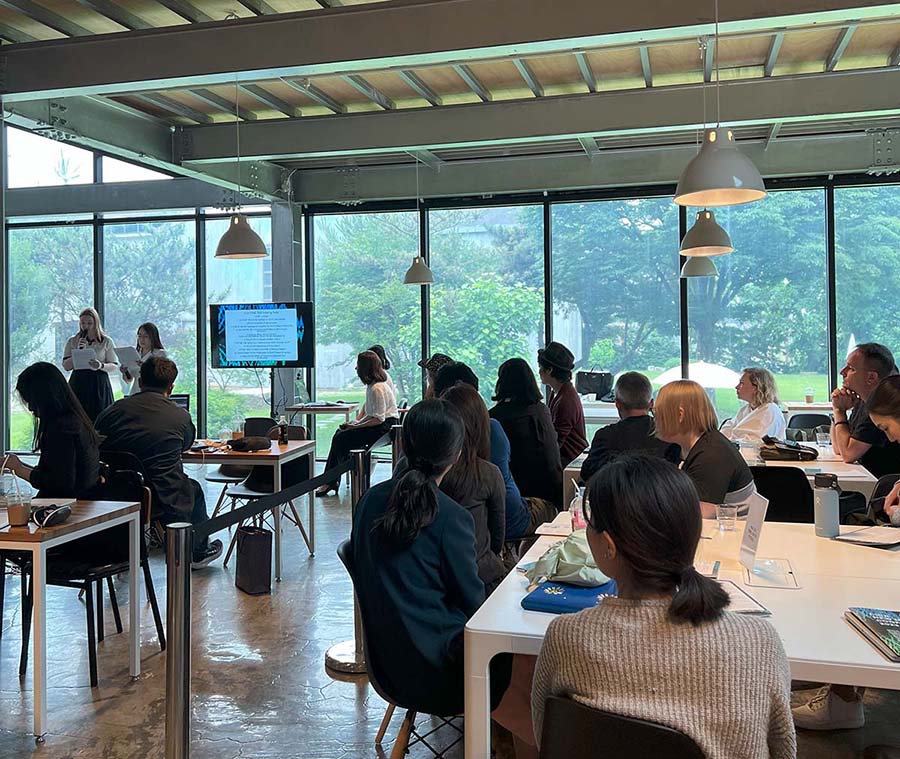
CICA NMAC 2023 Opening Party, photographed by Jimin Kang
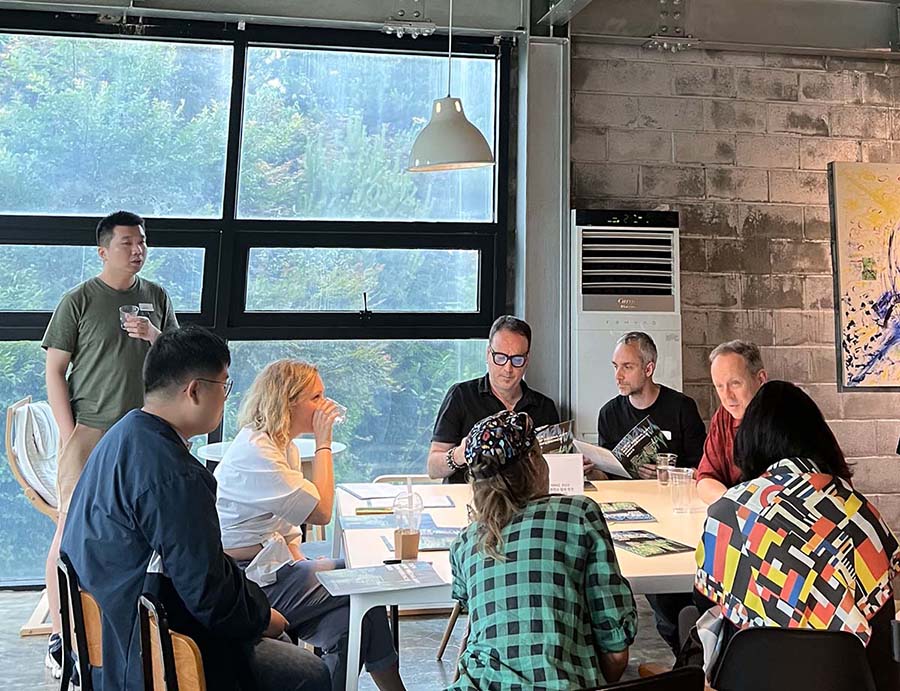
CICA NMAC 2023 Opening Party, photographed by Jimin Kang
경계의 사이에서, 존재를 탐구하다: 다학제적, 탈이분법의 뉴미디어 아트
손도연
최근, 미술관 혹은 예술가 등의 전문가 집단 고유의 창조물로 분류 되었던 예술이 미디어아트 매체의 진화에 의해 상호작용 가능한 ‘참여 예술’로 승화되고 있습니다. 또한 대중이 자신의 힘으로 변화를 주체적으로 수용하고 예술에 기반하지 않은 학자들도 예술 활동에 적극적으로 개입하여 주체적으로 창작 가능한 사회현상이 조성된 것입니다. 이는 펜데믹 등의 이슈에 대응하여, 기존의 미술관 방문 등에 국한 되었던 장소의 한계가 극복되고 예술작품을 직접 몸으로 체험하고자 하는 수용자의 욕망을 적극적으로 받아들이며 기존 예술과는 차별화 된 다른 영역의 시스템으로 발전된 것입니다. (1)
CICA Museum이 2023년 6월 10일부터 12일까지 개최한 New Media Art Conference (NMAC)는 이러한 매체의 발전과 더불어 탄생한 디지털 시대의 예술을 기념합니다. 예술과 환경, AI, 가상 및 증강 현실, 소셜 미디어, 펜데믹 시대의 예술 등 새롭게 대두되는 기술과 동향과 관련한 새로운 형태의 예술과 문화에 대한 생각을 공유하기 위해, 전 세계 26명의 미디어 아티스트들을 초대했습니다. 한국, 미국, 캐나다, 영국, 홍콩, 일본, 이탈리아, 프랑스 등의 다양한 배경을 가진 뉴 미디어 아티스트들은 발표 및 전시를 통해, 미디어아트가 가진 표현력의 특성에 대한 고찰과 중요성을 재조명하는 시간을 가졌습니다. 또한, 사회의식과 공존할 수 있도록 수용자의 창작품과 미디어 네트워크의 노출에 대한 책임의식에 대한 생각을 나누었습니다.
CICA NMAC 2023에서 가장 집중해야 할 점은 학문적, 문화적, 매체 간 경계에서 다양한 방식으로 표현되는 뉴 미디어의 잠재적 가능성이었습니다. 단순히 뉴 미디어를 활용한 창작물을 만드는 것을 넘어서서, 뉴 미디어가 가진 사회적 의미,가치 또는 한계와 더불어 앞으로의 뉴 미디어 아트에 대해 논의하는 것은 현 시대의 과제이기도 하기 때문에, 중요하게 논의 되었습니다. 특히, Song Lu는 AI 생성기 Midjourney를 사용하여 만들었습니다. 그러나 그녀는 AI를 통해 “아티스트” 정체성을 정의하는 것이 어렵다는 것을 알았습니다. AI는 나이든 서양 남성의 이미지를 생성하는 경향이 있기 때문입니다. 이것은 그녀가 “젊은” 또는 “여성” 아티스트에 대한 프롬프트를 추가했을 때 바뀌었습니다. 예술계에 더 많은 다양성이 필요하다는 것은 분명하며, 이는 우리가 예술가와 그들의 작품을 설명하는 데 사용하는 언어로 확장됩니다.
다양한 학문적 배경을 기반으로, 기술적인 관점에서 뉴 미디어에 접근한 아티스트들 중 Victor Drouin-Trempe & Jean-Philippe Côté 와 Masafumi Oda는 사운드 기반의 작업을 선보였으며, Oda는 Anti-Automationism 이라는 키워드를 가지고 끊임없이 순환하며 창작되는 뉴 미디어에 대해 언급했습니다. 또한, Sasha Opeiko, Hodoo, Kyungjin Yoo, Alex Frost는 현대 디지털 라이프의 상호 관계적 특성을 탐구하기 위한 작업을 선보였습니다. 더 나아가, Minyoung Kang, Dongwook Choi는 가상과 현실의 경계에 집중했습니다. Choi는 경계를 허물고 가상의 디지털 장면에서 물리적 현실로 사물을 옮겨낸 오브젝트들을 선보였습니다. Bo Choi & In-Ho Yi가 선보인 크리에이티브 컬렉션인 Zeitgeist – AI가 적용된 문화 천은 디지털 기술이 예술 작품을 만들고 제시하는 데 도움이 되는 도구라는 21세기 디자인 및 예술의 정신을 구현합니다. Jeon Sur는 이러한 기술적 논의를 바탕으로, 인공지능 창작물의 저작권 보호에 대해 발표했습니다.
인류적 탐구를 위해 뉴 미디어를 선택한 아티스트들은 Hyemin An, Dilara Koselioren, Dominick Rivers, Sinae Kim, Mila Dayan, Jeesoo Im은 기술로 모방하거나 대체할 수 없는, 우리를 “인간”으로 만드는 삶의 본질을 상기하는 것을 강조했습니다. Stéphanie Melyon-Reinette, Claudi Piripippi, Nikhil Mandalaparthy는 내면의 탐구를 통해 사회적 참여를 고민했습니다. 문화적 관점에 집중하여 뉴 미디어에 접근한 아티스트들 중 Okyoung Noh는 국경을 넘어 이동하는 몸과 국가 정체성에 대해 질문한다. 미국에서 이방인이 성취 불가능한 수월성과 그로 인해 불가능한 “아메리카”-되기를 증언한다. 또한, Susie Callista Suh는 한국계 미국인 여성으로서의 관점에서 아시아계 미국인 디아스포라 탐구를 보여주었다. 내면화한 미세한 공격과 노골적인 인종차별을 조명합니다. 그녀의 작업 주제에는 정체성, 기억, 역사 및 슬픔이 포함됩니다.
컨퍼런스 세션은 6월 12일에 서울대학교에서의 워크샵 및 투어를 끝으로 종료되었습니다. 서울대학교 곳곳의 건축적 특징을 살펴보며 질의하고, 한국의 아이덴티티가 녹아있는 재학생들의 작업 발표에 전 세계적 작가들의 질의에서 문화적 배경의 다양성에 따른 여러 관점과 의견을 살펴볼 수 있었습니다. CICA NMAC 2023의 마지막 일정을 통해, 아티스트들은 한국과 연결되고 문화를 공유할 수 있었습니다.
결론적으로, 2023 CICA Media Art Conference는 학문과 학문, 사람과 사람 등의 경계가 만나는 순간 탄생하는 감각들과 생각들을 내면화 할 수 있는 시간이었습니다. 이 과정에서 뉴 미디어 아트가 어떻게 우리를 표현하고, 경계하고, 감각하게 하는지 피부를 통해 느꼈습니다. 기술의 발전이 급속도로 이뤄지는 시간속 인간 대 인간의 커뮤니케이션과 기록되지 않은 감각들의 공유는 어떤 새로움을 만들까요? CICA NMAC 2023에 참가한 아티스트들은 3일간 깊게 상호작용하여, 각자의 의미있는 생각을 찾아가게 되었습니다.
(1) 이영우, 미디어아트를 통한 커뮤니케이션
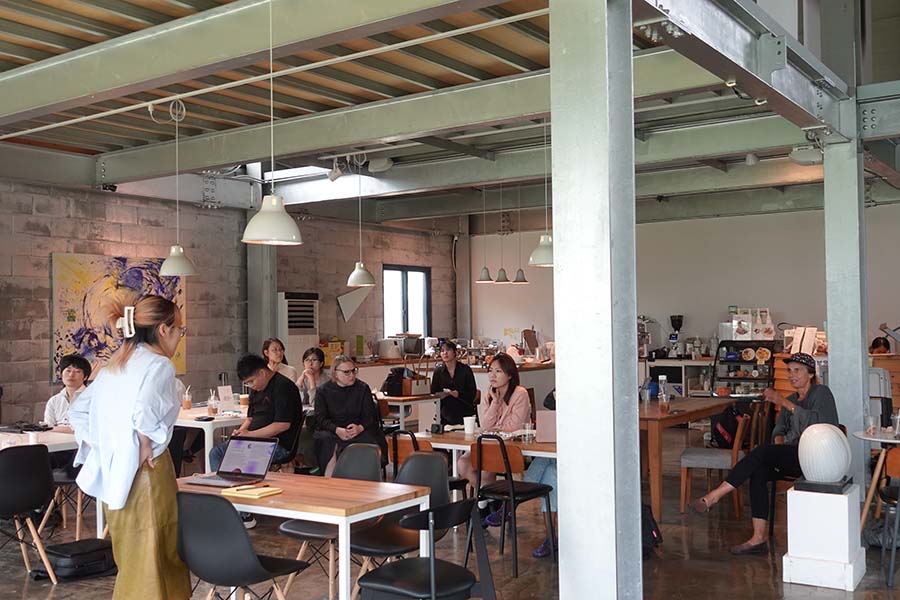
CICA NMAC 2023 Opening Party, photographed by Doyeon Son
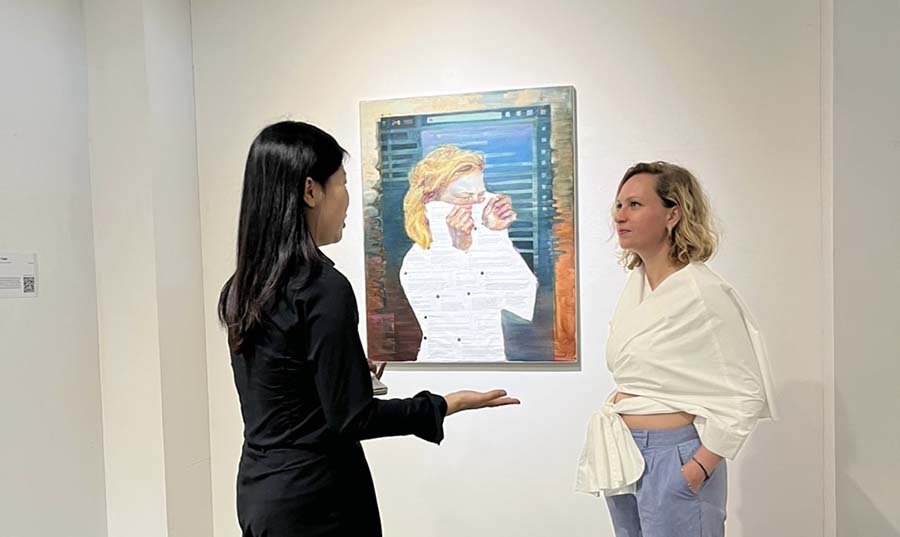
CICA NMAC 2023 Opening Party, photographed by Doyeon Son
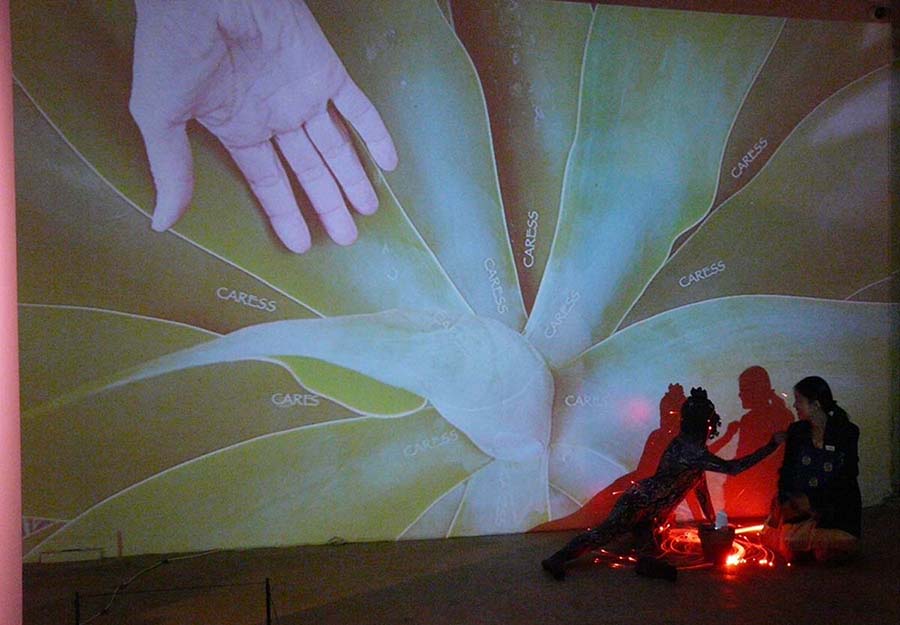
CICA NMAC 2023 Opening Party_Claudí Pirippi Performance, photographed by Yi Qian
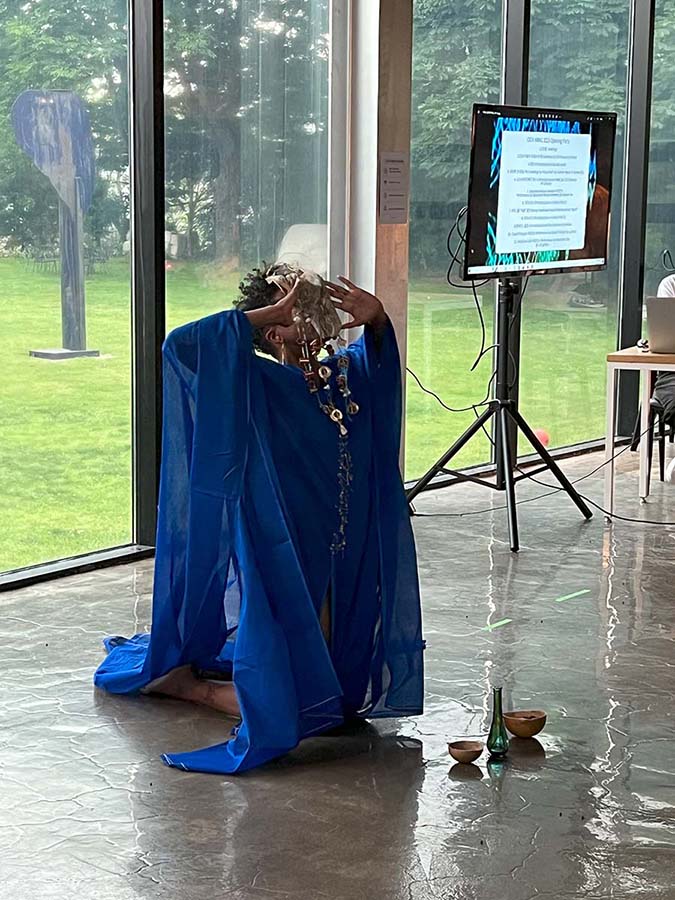
CICA NMAC 2023 Opening Party_Stéphanie Melyon-Reinette Performance, photographed by Jimin Kang
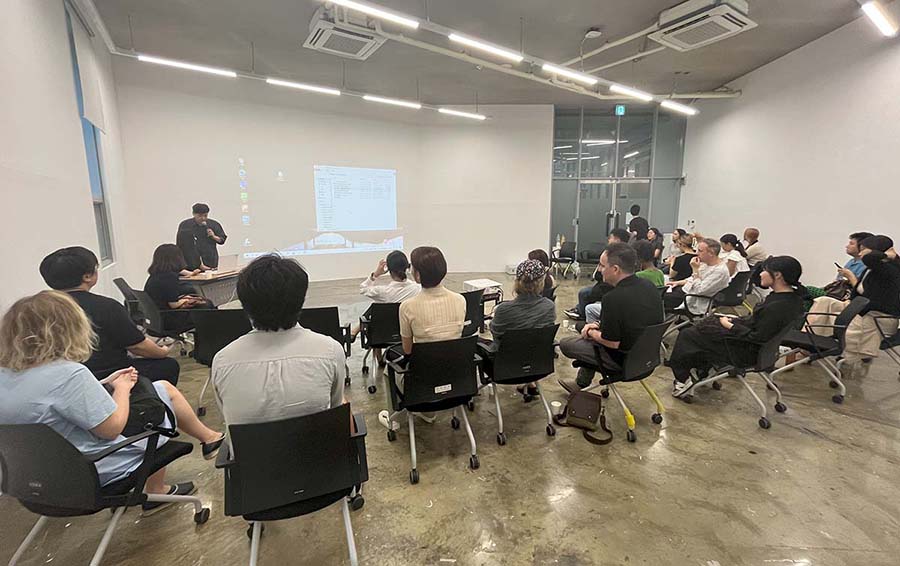
CICA NMAC 2023 SNU Workshop & Tour, photographed by Yi QIan
Between Boundaries, to Explore Existence: Multidisciplinary, De-dichotomous New Media Art
Doyeon Son
Recently, art, which was classified as a unique creation of a group of experts such as art galleries or artists, has been sublimated into an interactive ‘participating art’ by the evolution of media art media. In addition, the public independently accepts change on its own, and scholars who are not based on art actively intervene in artistic activities, creating a social phenomenon that can be created independently. In response to issues such as the pandemic, the limitations of places limited to visits to art galleries have been overcome, and the desire of the audience to experience art directly has been actively accepted, and it has developed into a system of other areas differentiated from existing art. (1)
The New Media Art Conference (NMAC), held by the CICA Museum from June 10 to 12, 2023, celebrates the art of the digital age that was born with the development of these media. We invited 26 media artists from around the world to share their thoughts on new forms of art and culture related to emerging technologies and trends, including art and the environment, AI, virtual and augmented reality, social media, and the arts of the pandemic era. New media artists from various backgrounds such as Korea, the United States, Canada, the United Kingdom, Hong Kong, Japan, Italy, and France had time to reconsider the characteristics and importance of media art through presentations and exhibitions. In addition, we shared our thoughts on the sense of responsibility for the exposure of the audience’s creations and media networks so that they could coexist with social consciousness.
The most important focus at CICA NMAC 2023 was the potential for new media represented in a variety of ways at academic, cultural, and intermedia boundaries. Beyond simply creating creations using new media, discussing the social meaning, values, or limitations of new media, as well as future new media art, is also a challenge of the present era, so it has been discussed importantly. In particular, Song Lu was created using the AI generator Midjourney. But she found it difficult to define an “artist” identity through AI. This is because AI tends to create images of older Western men. This changed when she added prompts for “young” or “female” artists. It is clear that there is a need for more diversity in the art world, which extends to the language that we use to describe artists and their work.
Based on diverse academic backgrounds, Victor Druin-Trempe & Jean-Philippe Côté and Masafumi Oda, among artists who approached new media from a technical perspective, presented sound-based work, and Oda mentioned new media that is constantly being created and rotated with the keyword Anti-Automationism. In addition, Sasha Opeiko, Hodoo, Kyungjin Yoo, and Alex Frost have presented their work to explore the interrelational characteristics of modern digital life. Furthermore, Minyoung Kang, Dongwook Choi focused on the boundary between virtual and reality. Choi introduced objects that broke boundaries and moved objects from virtual digital scenes to physical reality. Zeitgeist – AI-infused cultural fabric, a creative collection presented by Bo Choi & In-Ho Yi, embodies the spirit of 21st century design and art that digital technology is a tool to help create and present works of art. Based on these technical discussions, Jeon Sur presented copyright protection for artificial intelligence creations.
Artists who chose new media for human exploration highlighted the reminder of the essence of life that makes us “humans” that cannot be imitated or replaced by Hyemin An, Dilara Koselioren, Dominick Rivers, Sinae Kim, Mila Dayan, and Jeesoo Im. Stéphanie Melyon-Reinette, Claudi Piripippi, and Nikhil Mandalaparthy considered social participation through inner exploration. Among artists who have approached new media focusing on cultural perspectives, Okyoun Noh asks about the body and national identity moving across borders. In the United States, it testifies to the unachievable excellence of strangers and thereby to the impossible “America.” In addition, Susie Callista Suh showed an Asian-American diaspora exploration from the perspective of a Korean-American woman. It sheds light on internalized subtle attacks and blatant racism. Her work topics include identity, memory, history, and sadness.
The conference session ended on June 12 with workshops and tours at Seoul National University. I was able to look at the architectural characteristics of Seoul National University and look at various perspectives and opinions of cultural backgrounds in questions from writers around the world. Through the final schedule of CICAN MAC 2023, artists were able to connect with Korea and share culture.
In conclusion, the 2023 CICA Media Art Conference was a time to internalize the senses and thoughts created as soon as the boundaries of learning and learning, people and people meet. In this process, I felt through my skin how new media art expresses, warns, and senses us. What newness does human-to-human communication and the sharing of unrecorded senses create in time when technology advances rapidly? The artists who participated in CICA NMAC 2023 interacted deeply for three days to find meaningful thoughts.
(1) Young-Woo Lee, Communication through the Media Arts

